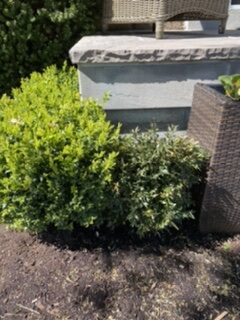
I am in north oakville with a front garden question that faces East (gets morning sun). I planted boxwoods around a concrete porch 2 years ago in newly provided good soil. They gradually keep dying off one by one and more seem to be dying off this year. I do fertilize. Initially I thought it was just winter kill and would trim off the dead but it keeps spreading. I tore two out last year. Now a 3rd is looking bad and I notice two more on the other side are starting to brown. I have attached pictures. I don’t want to lose them all.
Boxwoods may suffer due to cold winter injury and salt damage, fungal diseases, pests, incorrect soil, poor drainage, poor nutrition, or periods of drought. Any one of these issues alone or in combination can be detrimental. So, it is hard to pinpoint what is causing the problem with your boxwoods. Here are some suggestions to help grow boxwoods successfully.
Enrich the soil around the plants with compost in the spring to add nutrition and improve the soil structure, thus allowing better water absorption. Do not overfertilize. Carefully clean up of any leaf debris from around the plant.
Avoid any salt around boxwood roots. Perhaps, salt is coming off your porch in winter?
As the spring progresses, check for new buds. Once they start developing, you can cut back any damaged or dead branches. You may want to thin the plants lightly to permit better air circulation.
Avoid pruning boxwoods in the late summer or fall as this spurs new growth which won’t have time to harden off before winter and be killed by the cold. Also, avoid pruning boxwoods on very hot days. Make sure to sterilize any shears or clippers used to prune or trim all garden plants by soaking in bleach: water solution (diluted 1:9) or rubbing alcohol for 10 seconds
Water new boxwoods regularly with a deep soaking to keep the soil around the plant moist, but not soggy. Once established, boxwood plants will only require watering during drought periods. However, if the plants are close to the house under the roof overhang, they may not receive sufficient water from rain, and may need regular ongoing watering.
In the fall, make sure they get watered until the ground freezes. This is especially important in our South Central Ontario region where the ground can still be frozen on sunny days. When this happens the plant foliage starts to transpire, but the roots cannot replace the lost moisture from the frozen soil, so the foliage dies of dehydration.

